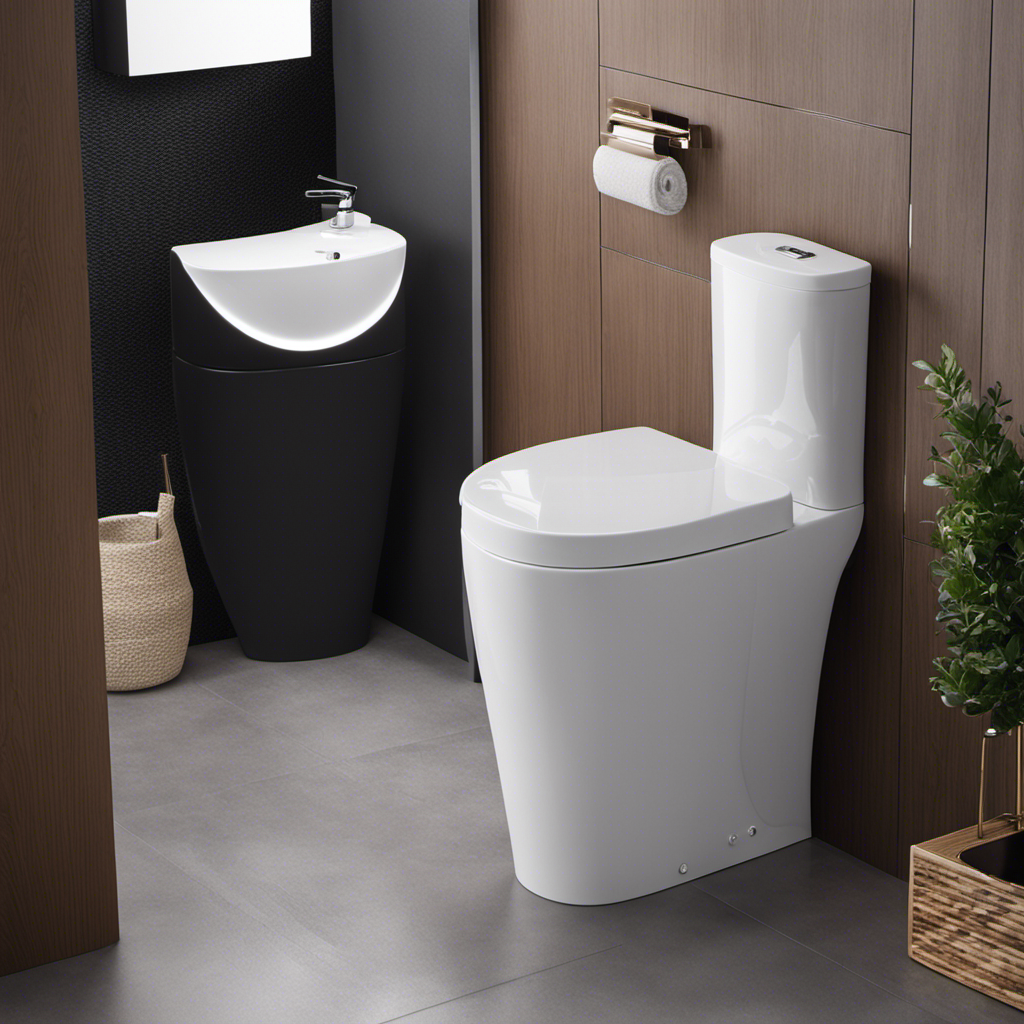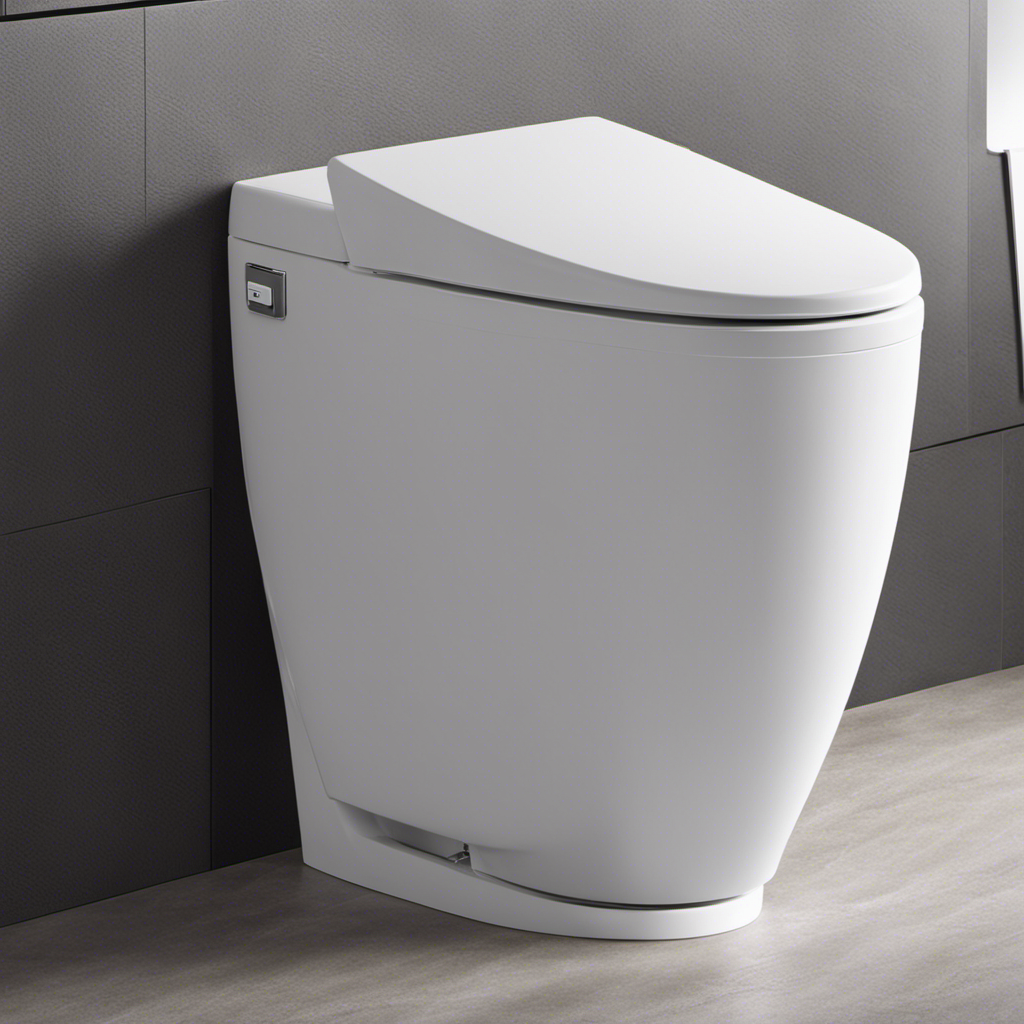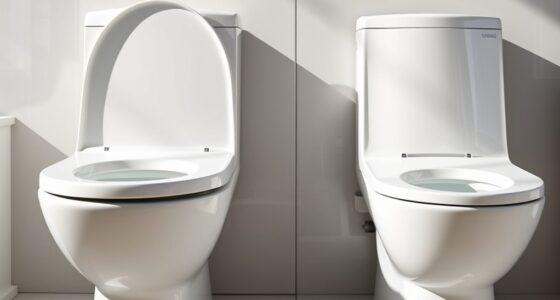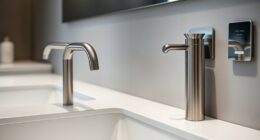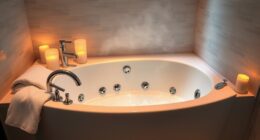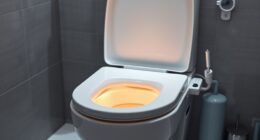In the ongoing battle of flushes, dual flush toilets and single flush toilets stand as symbols of water conservation and wastage, respectively.
Single flush toilets, with their fixed water usage per flush, contribute to water wastage and environmental harm.
In contrast, dual flush toilets offer a more efficient solution, allowing users to control the amount of water used for different types of waste.
While dual flush toilets may involve higher upfront costs and maintenance, their long-term benefits in terms of water efficiency and cost savings make them a worthy contender in this battle.
Key Takeaways
- Dual flush toilets use significantly less water than single flush toilets.
- Dual flush toilets can help reduce water bills and save up to 68% on water usage.
- Dual flush toilets contribute to water conservation efforts and reduce the strain on water resources.
- Dual flush toilets also reduce the energy required for water treatment and distribution.
Water Usage: A Comparison of Single and Dual Flush Toilets
Dual flush toilets use significantly less water than single flush toilets, with the option to use as little as 0.8 gallons for liquid waste compared to the average 1.6 gallons used by single flush toilets. This water efficiency comparison is crucial in understanding the impact on water resources.
By reducing water consumption, dual flush toilets help conserve this precious resource. Single flush toilets, on the other hand, use the maximum amount of water per flush, leading to significant water wastage. This wastage contributes to the strain on water resources and hampers water conservation efforts.
Implementing dual flush toilets can play a vital role in mitigating this issue by reducing water usage and promoting water efficiency. This, in turn, helps in conserving water and protecting the environment.
Cost Analysis: Evaluating the Financial Benefits of Dual Vs Single Toilets
Using a dual flush toilet can result in significant cost savings due to lower water consumption. When comparing the cost of dual flush toilets to single flush toilets, it is important to consider the long-term financial advantages of dual flush toilets.
While dual flush toilets may have a higher initial cost, the savings on water bills can offset this expense over time. Studies have shown that households can save up to 68% on water usage by switching to dual flush toilets. This cost savings can be particularly beneficial in areas with high water prices or water scarcity.
Additionally, some municipalities offer rebates or incentives for installing water-efficient fixtures like dual flush toilets, further reducing the overall cost. Therefore, when considering the financial benefits, it is clear that dual flush toilets are a cost-effective choice in the long run.
Environmental Impact: How Your Choice of Toilet Can Make a Difference
Switching to a more water-efficient toilet can have a positive impact on the environment. It reduces water waste and conserves valuable resources. Dual flush toilets, in particular, offer significant benefits in terms of water conservation. They have two buttons, one for liquids and one for solids. This allows users to control the amount of water used for flushing. Compared to single flush toilets, which typically use around 1.6 gallons of water per flush, dual flush toilets can use as little as 0.8 gallons for liquid waste. This not only saves water but also reduces the strain on water resources and contributes to water conservation efforts.
Using less water with dual flush toilets also helps to reduce the energy required for water treatment and distribution. Overall, the environmental impact of choosing a water-efficient toilet like a dual flush can make a significant difference in the preservation of water resources and the overall sustainability of our planet.
Maintenance and Durability: Exploring the Long-Term Prospects of Single and Dual Flush Toilets
Maintaining and ensuring the durability of both types of toilets is essential for their long-term functionality and performance.
When it comes to maintenance costs, single flush toilets have an advantage. They have fewer parts and are generally cheaper to repair. However, dual flush toilets may require additional maintenance due to the complexity of their dual button mechanism.
In terms of lifespan comparison, both types of toilets can last for many years with proper maintenance. However, single flush toilets may have a slightly longer lifespan due to their simpler design and fewer components. It is important to note that the lifespan of a toilet can also be influenced by factors such as water quality and usage habits.
Overall, regular maintenance and proper care are crucial for extending the lifespan of both single and dual flush toilets.
Customization and Design: Considering the Aesthetics and Options Available
The customization options and design variations available for both types of toilets allow homeowners to match their bathroom aesthetics and personal preferences. When considering the aesthetics and options available, here are some key points to keep in mind:
-
Customization Options: Both single flush and dual flush toilets offer various customization options. Homeowners can choose from different colors, shapes, and styles to suit their bathroom decor. Some toilets even come with customizable seat covers and accessories.
-
Aesthetic Considerations: The design of the toilet can greatly impact the overall look and feel of the bathroom. Homeowners can choose between sleek and modern designs or more traditional and classic styles. There are also options for different flush buttons or levers that can complement the overall aesthetic of the bathroom.
-
Eco-Friendly Designs: Many dual flush toilets are designed with water conservation in mind. They offer a more sustainable option by using less water for liquid waste and a slightly higher flush for solid waste. This eco-friendly design adds an additional layer of customization for those who prioritize environmental considerations.
-
Accessibility Features: Some toilets also offer customization options for accessibility. These features include higher seats, handrails, and bidet functions. These options are particularly beneficial for individuals with mobility issues or disabilities, allowing them to have a toilet that meets their specific needs.
Overall, the customization options and design variations available for both single flush and dual flush toilets allow homeowners to create a bathroom that not only functions well but also reflects their personal style and preferences.
Water Conservation: The Role of Dual Flush Toilets in Sustainable Living
Using significantly less water than single flush toilets, dual flush toilets play a crucial role in sustainable living by conserving water and reducing the strain on water resources. These toilets offer two flush options, one for liquid waste and one for solid waste, allowing users to control the amount of water used for flushing.
On average, single flush toilets use around 1.6 gallons of water per flush, while dual flush toilets can use as little as 0.8 gallons for liquid waste. This significant difference in water usage leads to substantial water savings over time.
Many countries and regions have recognized the water-saving benefits of dual flush toilets and have implemented regulations and incentives to encourage their use. While dual flush toilets may have a higher initial cost and require additional maintenance, the long-term cost savings and positive environmental impact make them a worthwhile investment.
Consumer Perspectives: Real-Life Experiences and Feedback on Single and Dual Flush Toilets
Consumers have shared their real-life experiences and feedback on the effectiveness and cost savings of both single and dual flush toilets. Here are some key insights:
-
Consumer satisfaction: Many users express satisfaction with dual flush toilets, citing their ability to save water without compromising flushing power. The option to choose between a light flush for liquids and a heavier flush for solids is highly appreciated.
-
Water efficiency: Consumers value the water-saving capabilities of dual flush toilets. By using less water per flush, these toilets contribute to water conservation efforts and help reduce water bills.
-
Cost savings: While dual flush toilets may have a higher upfront cost compared to single flush toilets, the long-term savings on water bills make them a worthwhile investment. Studies show that households can save up to 68% on water usage by switching to dual flush toilets.
-
Environmental impact: Consumers recognize the environmental benefits of dual flush toilets in reducing water wastage and conserving resources. By choosing a dual flush toilet, individuals can contribute to a more sustainable future.
Frequently Asked Questions
Are There Any Regulations or Incentives for Using Water-Efficient Fixtures Such as Dual Flush Toilets?
Yes, there are regulations and incentives for using water-efficient fixtures like dual flush toilets. These aim to promote water conservation and reduce water wastage. Dual flush toilets are cost-effective in the long run due to their lower water consumption.
How Much Water Can Households Save by Switching to Dual Flush Toilets?
Switching to dual flush toilets can save households a significant amount of water. With the ability to use as little as 0.8 gallons for liquid waste, these water-saving technologies greatly reduce water consumption and have a positive environmental impact.
Do Dual Flush Toilets Require More Maintenance Compared to Single Flush Toilets?
Dual flush toilets generally require more maintenance compared to single flush toilets. The dual flush mechanism, with its additional parts, may be more prone to issues. However, the long-term cost savings and water conservation benefits of dual flush toilets may outweigh the maintenance requirements.
Can the Initial Higher Cost of Dual Flush Toilets Be Offset by Long-Term Water Bill Savings?
The initial higher cost of dual flush toilets can be offset by long-term water bill savings. Additionally, their environmental impact is positive as they conserve water and reduce strain on resources.
Are There Any Rebates or Incentives Available for Installing Dual Flush Toilets in Certain Municipalities?
Rebates and incentives for installing dual flush toilets in certain municipalities can help offset the initial higher cost. These programs encourage the use of water-efficient fixtures, like dual flush toilets, to conserve water and promote environmental sustainability.
Conclusion
In conclusion, the battle of flushes has revealed that dual flush toilets are the superior choice when it comes to water efficiency, cost savings, and environmental impact.
By allowing users to control the amount of water used for flushing, dual flush toilets significantly reduce water consumption and contribute to water conservation efforts.
Despite being more expensive and requiring additional maintenance costs, the long-term financial benefits of reduced water bills make dual flush toilets a worthwhile investment.
Furthermore, the customization and design options available for dual flush toilets cater to individual preferences.
Overall, choosing a dual flush toilet is a smart and sustainable choice for those looking to make a positive impact on the environment while enjoying the benefits of modern technology.
